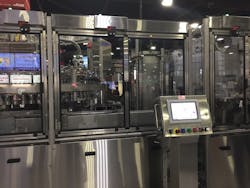In this era of early Industrial Internet of Things (IIoT) projects, plans and visions, the initial points of focus have centered on two key objectives: improved decision-making based on better data analysis and enhanced, proactive maintenance via connectivity to equipment for remote monitoring, diagnostics and even software-enabled repair. Though not absent from these initiatives, safety has taken somewhat of a backseat in most IIoT-related discussions.
At Rockwell Automation’s Automation Fair 2016, however, the topic of “Safety in the Connected Enterprise” played a central theme. Featuring a can filler machine from Bevcorp destined for use by Coca-Cola, Rockwell Automation’s connected safety display highlighted how machinery is increasingly being designed for IIoT-related connectivity in ways that include safety. In this example, the filler machine is outfitted with Netbiter from HMS to upload data to the cloud for remote diagnostics, activity, maintenance and safety insights.
“With FactoryTalk View and Metrics we’re looking to change the safety process from following lagging indicators like safety-relayed events, to identifying leading indicators,” said Steven Ludwig of Rockwell Automation. “The ability to do this is based on being able to predict safety events in advance.”
Ludwig explained that comparing actual events to expectations to “see if a machine is behaving as expected and to see if people are behaving as expected” enables such predictions. Worker behavior can greatly impact machine life as well as safety policy and procedures, he said, adding that the occurrence of more shutdowns than a machine is designed for can cause heavy wear on motors and lead the their early failure.
“Insight into incidents and related behaviors that can cause this to happen is helping OEMs understand the value of IIoT,” he added.
Despite the eye opening insights into machine activity that can now be delivered to OEMs via IIoT technology, Dave Krieger of Rockwell Automation says that more end users than OEMs are currently requesting IIoT connectivity. “End users are asking for this remote access and that’s driving OEMs who are still not entirely aware of the possibilities to explore it more. Users see that, when you’re processing 1,200 cans per minute, you’re losing a lot of money with any amount of unplanned downtime. With FactoryTalk View, if machine goes down you can see everything that caused it and track it for analysis.”
Having this level of insight is “bringing together companies’ environmental health and safety departments with the engineering departments,” added Ludwig. “This is good for safety programs that address culture, policies and procedures, and engineering of equipment.”
Ludwig highlighted Rockwell Automation’s Safety Automation Builder with RASWin (Risk Assessment Software Win) as key tools to help connect the people in these departments and their responsibilities. The merger of these two systems was announced at Automation Fair 2016. “The integration of machine safety risk assessment and design helps document the entire safety development process,” he said. “The best way to get rid of risk is to design it out from the beginning.”
RASWin is the starting point in designing the safety lifecycle of a machine, Ludwig said, explaining that RASWin lists the safety functions of a machine’s design. Once those functions are determined, RASWin brings the user into Safety Automation Builder to specify parts for implementation.
“Safety Automation Builder is Rockwell Automation’s design and verification tool for use after the risk assessment,” said Ludwig. “It makes the design of a safe machine real. It defines all the components you need to make a machine’s safety functions real. It lays out the safety logic of the machine and identifies hazards.”
Drop-down menus in Safety Automation Builder guide the user through the component specification steps that, not so long ago, required engineers to thumb through a parts catalog. “With Safety Automation Builder, you end up with the complete part number for the exact component you need,” said Ludwig. “The Safety Automation Builder process includes input sensors, logic and output for each component. Then you can do calculations on the machine design with the exact parts that will be used to determine that it meets safety requirements.”

